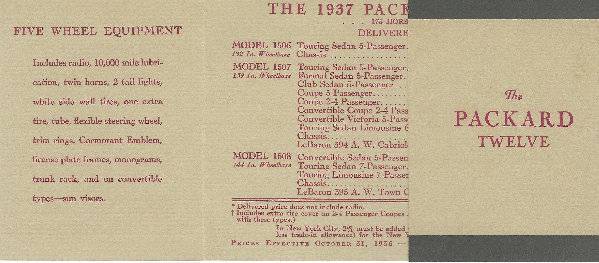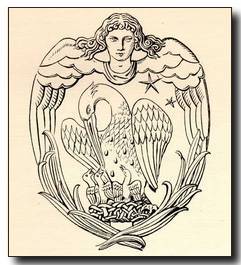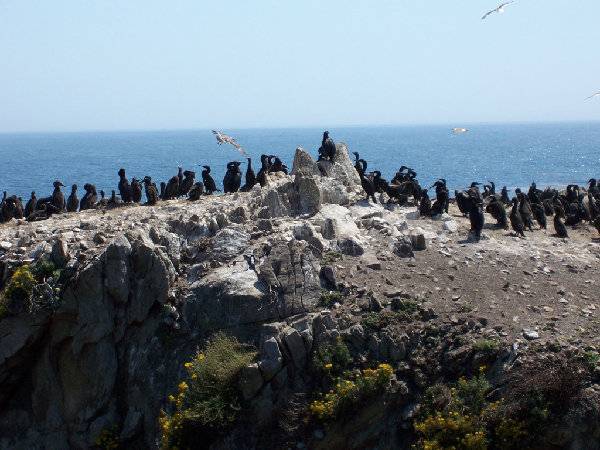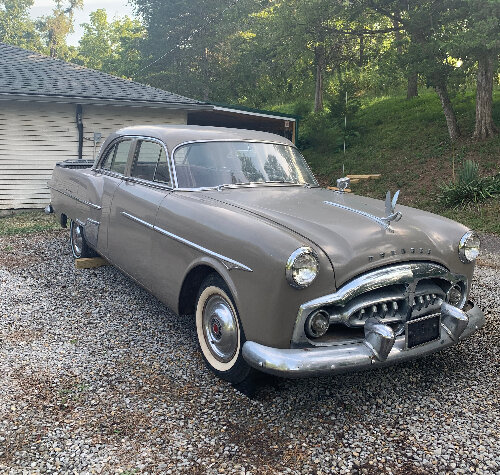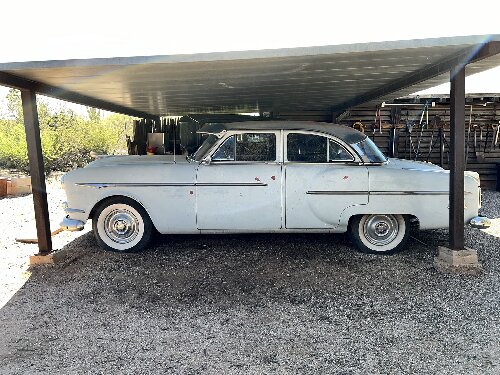|
Re: Earliest documented use of designation 'cormorant'???????
|
||||
|---|---|---|---|---|
|
Home away from home
|
Bob
I think this is covered either in the Automobile Quarterly book or in an old issue of The Cormorant. Someone will probably chime in to correct me. Packard didn't commit themselves for years and both terms were used. "Cormorant" was chosen about 1953 when they had more pressing issues to attend to. Most human behaviors are predictable ! Happy New Year! John Harley
Posted on: 2018/12/23 18:30
|
|||
|
||||
|
Re: Earliest documented use of designation 'cormorant'???????
|
||||
|---|---|---|---|---|
|
Forum Ambassador

|
Good memory John, there was an article, perhaps 40 years ago in The Cormorant about the pelican vs. the cormorant. An index to all back issues of The Cormorant is on their website, should be easy enough to find the article.
PS, it's in the Fall 1974 issue. Also a pair of letters on the topic in the Spring 1975 issue. I'll look it up next week.
Posted on: 2018/12/23 19:29
|
|||
|
||||
|
Re: Earliest documented use of designation 'cormorant'???????
|
||||
|---|---|---|---|---|
|
Home away from home
|
Thanks for helping with this question. Somehow I always thought it was started in the early 40s.
....
Posted on: 2018/12/23 21:08
|
|||
|
||||
|
Re: Earliest documented use of designation 'cormorant'???????
|
||||
|---|---|---|---|---|
|
Home away from home
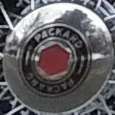
|
W.C. Williams, author of "The Heraldic Packard," Appendix VI on page 767 of the Kimes-edited Packard History book, wrote that the Packard advertising department decided that 'Cormorant" sounded more dignified than "Pelican" and first used the term in an accessories catalog for the Seventeenth Series cars in mid-1938. The word was used again in the 1940 Data Book, copyrighted in August, 1939. This was done without seeking management approval and apparently launched a decade-long debate on the issue. Finally, Packard Vice-President Milton Tibbetts issued a memo in 1949 stating that the original designers had intended the bird to be a pelican and that is what it should be called.
Today, 80 years later the matter still seems to be unsettled. Many viewers of my 1954 Convertible have commented on the beauty of the "Swan" hood ornament. So be it a Pelican, Cormorant or a Swan I think we all can agree it is one beautiful bird.
Posted on: 2018/12/23 23:27
|
|||
|
Don Shields
1933 Eight Model 1002 Seven Passenger Sedan 1954 Convertible |
||||
|
||||
|
Re: Earliest documented use of designation 'cormorant'???????
|
||||
|---|---|---|---|---|
|
Forum Ambassador

|
Bud Juneau's article in the Fall 1974 issue of the The Cormorant identifies late 1938, in the 1939 Data Book, as the first known reference to the "bird" ornament as a cormorant. This agrees with the information Don presented just above.
However, a letter to the editor in the following (Spring 1975) issue of The Cormorant by Jack Triplett identifies a PMCC document titled "Price Information on the New Packard Cars" and bearing the imprint of the De Pugh Motor Company of Lancaster PA and the date of February 1932 and it lists by specific name the "Cormorant" radiator mascot at $20 and the "deluxe" ornament (the much-loved donut pusher) at $10. So it would seem, since the ornament was introduced for 1932, it was a cormorant from the get-go, at least in some documents; that leaves the question when did it become a pelican? The 1934 Accessory Catalog called it a pelican, I don't have that document for 1933. Those in the pelican camp do have a bragging point for whatever that's worth; the bird feeding it's brood in the Packard family crest is a pelican.
Posted on: 2018/12/24 14:05
|
|||
|
||||
|
Re: Earliest documented use of designation 'cormorant'???????
|
||||
|---|---|---|---|---|
|
Home away from home
|
WOW! That certainly beats my 1937 documentation!
I have a small trifold that was offered by PACKARD MOTOR CAR COMPANY of NEW YORK for the 1937 Twelve. It offered the 'Cormorant Emblem' in their standard accessory package.
Posted on: 2018/12/24 14:33
|
|||
|
||||
|
Re: Earliest documented use of designation 'cormorant'???????
|
||||
|---|---|---|---|---|
|
Home away from home

|
Quote:
The pelican vs. cormorant is another one of these facets of Packard lore that will likely be argued about forever and forever. The one thing that most don't realize is that people who write text for car companies (and others) often don't bother to look up the official company nomenclature and simply insert whatever name they find to their choosing. But then people see it on a brochure or manual and that's argument evidence that can last ad infinitum. People presume any deviation from company terms means printed on a company publication certainly must have the blessing of the company. But this just isn't always the case. I haver actually seen this done in the automotive business. A reference in the owner's manual or parts book may end up conflicting with what the sales and advertising guys say in the brochures... and then again both of these might conflict with engineering terms. This is how these things usually get started. Quickest thing that comes to mind is the use of the term "tonneau" when what is really being described is a "boot" or "dust boot" in convertibles. Of course all this gets crazier when we mix terms from outside of the USA where, for instance, a "boot" is what North Americans refer to as a "trunk." Somebody, somewhere at Packard simply wrote in one term in place of the other... and it was game-on ever since. The term "Swan" was commonly used by at least two different aftermarket hood ornament makers starting in the 1940s and 1950s. The aftermarket guys used this term in order to avoid getting into trouble with Packard... but didn't seem to worry a bit about copying the bird. People saw these things on the shelves at Pep Boys, Western Auto, and others... also in the J.C. Whitney catalogues, so this is likely how "Swan" terminology got so widespread. It is still used today in labeling and marketing the Packard clone bird ornament they still sell. If you are driving cross-country, stop in and look around in the retail area of any good-sized truck stop and you may see one for sale on the racks. They sell lots of these to long-haul truckers. The two biggest makers of clone Packard birds were both located in Illinois. I have original catalogues for both. One of them shows over 24 different versions for 1955. Both companies also made smaller versions for motorcycles and even smaller still ones for bicycles. One catalogue shows even more names, such as "Flamingo" (looks just like the Packard bird, only with a slightly thicker head) and another version with lowered wings they refer to as the "Bugler." Smaller versions of the bird are called "Swanettes" and come either all chromed metal or with illuminated plastic wings... or just plastic wings. Some of the "Bugler" birds were made in gold plating. Then they have what they call "Jiffy Swan," "Jiffy Swanette," "Jiffy Bugler" and "Jiffy Flamingo" models. Ohhh... and instead of "Sliding boy" they have "Sliding Girl" ...uh, I won't describe that one-use your imagination. Anyway, page after page after page of clone Packard birds. There have also developed at least two different names for another Packard ornament which we always called "the donut chaser" but which I see more recently being called "donut pusher."
Posted on: 2018/12/24 14:56
|
|||
|
||||
|
Re: Earliest documented use of designation 'cormorant'???????
|
||||
|---|---|---|---|---|
|
Home away from home

|
The latest use of the "Cormorant"
http://www.tactical-robotics.com/category/cormorant https://m.youtube.com/watch?v=obBRAbrLC3I https://m.youtube.com/watch?v=F2zgr3SRlhU https://m.youtube.com/watch?v=PByFlMyAYpg What hood ornament should be on one?
Posted on: 2019/5/11 19:53
|
|||
|
||||
|
Re: Earliest documented use of designation 'cormorant'???????
|
||||
|---|---|---|---|---|
|
Home away from home
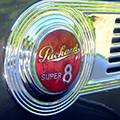
|
Yes, we've been through this before, but the fact is, it's a pelican.
From the Catholic education resource center "The symbolism of the mother pelican feeding her little baby pelicans is rooted in an ancient legend which preceded Christianity. The legend was that in time of famine, the mother pelican wounded herself, striking her breast with the beak to feed her young with her blood to prevent starvation. Another version of the legend was that the mother fed her dying young with her blood to revive them from death, but in turn lost her own life. Given this tradition, one can easily see why the early Christians adapted it to symbolize our Lord, Jesus Christ." I know most images and cartoons of pelicans show them with a geezer neck, and that cormorants have seemingly longer neck like the hood ornament; but the attached illustration shows how the design of the hood ornament is clearly derived from a pelican. The cormorant simply doesn't have the symbolism. Joe has spoken. (And I'd never call the Goddess of Speed a donut chaser, or pusher for that matter, any more than I'd call San Francisco 'Frisco or the Washington Monument the pencil building.)
Posted on: 2019/5/12 13:34
|
|||
|
||||

 (224.37 KB)
(224.37 KB)